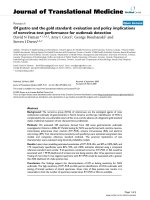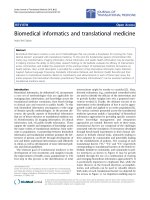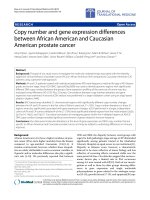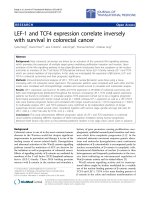Báo cáo hóa học: " Editorial Opportunistic and Delay-Tolerant Networks Sergio Palazzo,1 Andrew T. Campbell,2 and Marcelo Dias de Amorim3" pot
Bạn đang xem bản rút gọn của tài liệu. Xem và tải ngay bản đầy đủ của tài liệu tại đây (425.87 KB, 2 trang )
Hindawi Publishing Corporation
EURASIP Journal on Wireless Communications and Networking
Volume 2011, Article ID 164370, 2 pages
doi:10.1155/2011/164370
Editorial
Opportunistic and Delay-Tolerant Networks
Sergio Palazzo,
1
Andrew T. Campbell,
2
and Marcelo Dias de Amorim
3
1
University of Catania, Catania, Italy
2
Dartmouth College, Hanover, NH 03755, USA
3
UPMC Sorbonne Universit´es, 75005 Paris, France
Correspondence should be addressed to Sergio P alazzo,
Received 18 January 2011; Accepted 18 January 2011
Copyright © 2011 Sergio Palazzo et al. This is an open access article distributed under the Creative Commons Attribution License,
which permits unrestricted use, distribution, and reproduction in any medium, provided the original work is properly cited.
Today, people predominately rely on the Internet and cellular
network, as well as the plain old telephone system, to com-
municate with each other. Typically, these communication
services are built from fixed wired or wireless infrastructure,
where the “next hop” is known in advance, well engineered
and its performance in terms of delay, throughput, and loss
characteristics has been well studied. Over the last decade,
a new paradigm in end-to-end communications has
emerged, mostly in academia and industrial research labo-
ratories, based on the notion that the next hop between a
sender and receiver is not known in advance. These networks,
typically called opportunistic and delay-tolerant networks, are
characterized as opportunist ic because, like nodes in mobile
ad hoc networking infrastructure, the forwarding nodes are
mobile and dynamic—they come and go in unpredictable
ways. In this case, it is very hard to make strong statements
about the type of service opportunistic networks will offer
the user. Opportunistic nodes collectively form dynamic
networks that are built from short unpredictable contact
times as nodes move in and out of connectivity. Unlike
mobile ad hoc networks, which aim to o ffer a frequently
available connected path through a dynamic network, oppor-
tunistic networks only offer a store and forward service
in a mostly disconnected network comprised of infrequent
contact times between nodes—therefore, these networks aim
to find the next “storage node” toward the destination as
a primary communications service. Because of this, most
applications have to be delay tolerant in nature, hence the
name: opportunistic and delay-tolerant networks.
Many applications of opportunistic and delay-tolerant
networks are b eing actively studied, for example, networks
purely comprised of people carrying devices that only use
short range radios, wildlife-based mobile low-power sensor
networks, and interplanetary networks. While this new form
of communication has created great interest in the research
community, it is s till in its infancy in terms of emerging
communications architectures, algorithms, protocols, tools,
modeling, and standards. As yet there has been “no killer
app” that has emerged other than the grand challenge of
interplanetary communications or niche deployments in
sensor networks or mobile human-centric experimental
networks. However, these networks show great promise
in terms of their fully decentralized design making them
extremely robust. They also offer the potential for huge
bandwidth gains in contrast to other forms of networks (e.g.,
MANETs or the existing cellular network) but at the cost of
higher end-to-end delays.
The duality of higher bandwidth gains over short-lived
next-hop connections and longer end-to-end delays, coupled
with the spontaneous creation of dynamic networks, has
captured the imagination of networking researchers. The
papers in this special issue, which was promoted under the
auspices of the EC-funded Network of Excellence in Wireless
Communications (in particular, the Work Package WPR.11
on Opportunistic Networks), address a number of the issues
and challenges discussed above. We received a total of 2 3
high-quality su bmissions. The papers came f rom different
regions around the world and addressed many different
aspects of research. Each paper was rev iewed by three or
more experts, who evaluated the technical content and
suitability of the paper for publication in this special issue.
AsGuestEditorsofthespecialissuewehadtheverydifficult
job of selecting only 10 papers from those submitted.
The papers of this special issue cover both practical
and theoretical aspects of opportunistic and delay-tolerant
networking.
2 EURASIP Journal on Wireless Communications and Networking
The first group of papers addresses several implemen-
tation issues ranging from deployments in real situations
to improvements of communication techniques. Quwaider
et al. p ropose a new modeling framework for routing
in wireless body-area networks (WBANs). The idea is to
consider possible disconnections due to postural parti-
tioning. Several experimentations and simulation studies
show that the model is representative of situations found
in reality. In the context of natural sciences, Rutishauser
et al. propose a monitoring system to observe wildlife in
their natural habitat. The system, named CARNIVORE,
consists of a set of sensors carried by animals and static
collectors whose role is to gather readings to be sent on the
Internet. The particularity of the proposed architecture is
to deal with intermittent connectivity in an efficient way.
Soares et al. address the problem of data collection when
the network does not have sufficient density to operate
using traditional communication solutions. The authors
propose an original strategy that relies on replication to
circumvent the constraints introduced by disconnections.
Through implementation and simulation, the authors show
that the proposed strategy leads to improved delivery ratios.
Wang et al. focus on the especially challenging DTN scenario
of interplanetary communications. Extreme distances that
translate into long link delays and frequent link disruptions
characterize such a scenario. The authors investigate the
DTN architecture w ith a bundle protocol (BP) running over
the TCP-based convergence layer (TCPCL) protocol and
show that the goodput rate is more dictated by disruption
delays than bit error rate. P
´
erennou et al. present the last
paper of this first group. They propose triggers on top of
the KauNet emulator to evaluate the reaction of applications
and protocols to lower layer events. The main contributions
of this work are the integration of the DTN reference
implementation and the emulation of a DTN data-mule
scenario.
The second group of papers reports recent advances
on theoretical aspects of opportunistic and delay-tolerant
networks. Castro et al. consider the interesting scenario of
peer-to-peer file sharing in delay-tolerant rural scenarios.
The authors compare two schemes initially conceived for
general wireless networks and show that they apply to
an opportunistic situation when replication is used as
a substrate for lookup. Through a number of simulations,
the authors show the suitability of the schemes under
a number of situations. Kubo et al. also consider peer-to-
peer networking but in the case of multicast communications
running on mobile nodes. They propose a new strategy for
resource allocation at nodes that considers a single parameter
called relay ability, which is in fact a combination of avail-
able bandwidth, disconnection r ate, and remaining battery
capacity. Simulation results show the interest of the proposed
scheme. Also in the context of resource optimization, Zhang
et al. analyze the efficiency of opportunistic relaying under
different realistic radio channel conditions. In particular, the
authors provide the lower bound that corresponds to the best
tradeoff between energy and latency minimization. Fabbri et
al. focus on the most fundamental problem of opportunistic
and delay-tolerant networking, that is routing. The authors
propose to rely on social information to derive efficient
forwarding rules. More specifically, they suggest the use of
a scalar parameter that captures a node’s social behavior in
terms of frequency and types of encounters. The interest of
the proposed scheme is confirmed through the examination
of vehicular traces. Finally, Samuel et al. address routing
from the point of view of self-organizing structures. They
propose an improvement over a companion work on the
use of super nodes to provide seamless communications for
roaming users over interconnected heterogeneous wireless
networks. The improvement consists in including a better
understanding of node mobility into the model, which leads
to a better strategy as shown by the authors in the paper.
Acknowledgments
We would like to take this opportunity to thank the authors
of all submitted papers for considering our special issue for
disseminatingtheirwork.Wearealsoverygratefultothe
numerous referees who spent their o wn time to review the
manuscripts in a responsive and accurate way: this definitely
helped improve the quality of the papers that have been
eventually accepted. We would also like to thank the staff
of Hindawi for their valuable assistance through the entire
editing process, and the Editor-in-Chief of the journal, Luc
Vandendorpe, for trusting us with this important assignment
and helping us to fulfill it successfully. Last but not least, we
thank the members of NEWCOM++ for their collaboration
in submitting high-quality papers to this special issue.
Sergio Palazzo
Andrew T. Campbell
Marcelo Dias de Amorim









